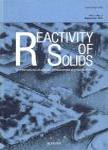版权所有:内蒙古大学图书馆 技术提供:维普资讯• 智图
内蒙古自治区呼和浩特市赛罕区大学西街235号 邮编: 010021

作者机构:Metallurgy Program Department of Materials Science and Engineering The Pennsylvania State University University Park PA 16802 U.S.A.
出 版 物:《REACTIVITY OF SOLIDS》
年 卷 期:1988年第5卷第2-3期
页 面:177-190页
核心收录:
学科分类:07[理学] 070203[理学-原子与分子物理] 0703[理学-化学] 0702[理学-物理学]
基 金:National Science Foundation NSF (DMR-82-03104)
摘 要:The composition of γ-iron nitride (“Fe 4 N) was measured by a thermogravimetric method at 450–550°C at various nitrogen potentials. The composition (wt.-% of nitrogen) limits at 450, 500 and 550°C range from 5.82 to 5.90%, 5.78 to 5.90% and 5.71 to 5.89%, respectively. The results can be described satisfactorily by two thermodynamic relations: (i) a Langmuir-type isotherm that assumes all nitrogen atoms reside at regular, octahedral sites (1/2,1/2,1/2), and (ii) by considering “Fe 4 N as a substantially ordered solution of nitrogen in iron with two types of minor disorder: (a) nitrogen vacancies at regular sublattice sites, and (b) interstitial nitrogen atoms which reside at the disordered sites of (1/2,0,0), (0,1/2,0) and (0,0,1/2). At a fixed temperature, it can be shown that the fraction of interstitial nitrogen increases with increasing nitrogen potential, whereas the fraction of nitrogen vacancies decreases with increasing nitrogen potentials. As the temperature is increased from 450 to 550°C, both types of defect increase with the fraction of interstitial nitrogen increasing from 0.21 to 0.35% at the γ/ϵ phase boundary, while the fraction of nitrogen vacancies increased from 1.42 to 3.47% at the α/γ phase boundary. From the nitrogen activity at α/γ equilibrium, the standard enthalpy and entropy of formation of “Fe 4 N from α-iron and molecular nitrogen are found to be −9065.2 J mol −1 Fe 4 N (−2165.6 cal mol −1 Fe 4 N) and −47.5 J K −1 mol −1 Fe 4 N (−11.3 cal K −2 mol −1 Fe 4 N), respectively.